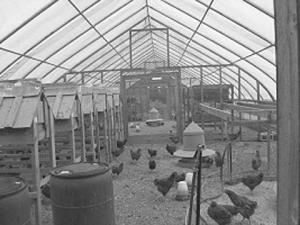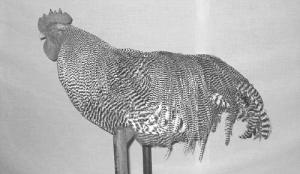This Greenhouse Is For The Birds
While most people raise plants in greenhouses, Alvin Theriault raises jungle cock and genetic hackle, birds that are highly valued by fly fishermen. Theriault sells the feathers loose or as pelts and also sells flies he has tied himself, up to 10,000 a year.
"You need the feathers to tie the flies, and they don't last forever, so the feathers are always in demand," says Theriault, Stacyville, Maine.
He needs a source of feathers year-round. After determining that both breeds did better on dirt and with as much light as possible, he decided a greenhouse would be the answer.
University of Maine Extension poultry specialists told him a greenhouse wouldn't work, because it would be too humid. "They were thinking of controlled temperatures and watered plants," says Theriault. "Without plants and high heat, humidity is not a problem."
Maine snows would be a problem, though. He knew the greenhouse walls couldn't withstand snow sliding off the roof and piling up against the sides. His answer was to put the greenhouse on top of a dirt pad 3 to 4 ft. above surrounding ground level.
The commercial 27-ft. by 100-ft. greenhouse with a single layer of 15-mil polyethylene covering it lets him keep up to 1,000 birds at a time. In the summer, he simply lifts the sidewalls to provide ample ventilation. Cold winter temperatures and even wind have been no more of a problem than summer heat. Theriault credits the dirt floor for absorbing sunlight and releasing the heat over night.
"We get 20 below zero temperatures and yet the temperature at eye level in the greenhouse has never gotten below zero," says Theriault. "It would be even warmer if I had gone with a double layer of plastic with air in between for insulation like most greenhouses use."
In addition to selling the feathers and flies made from his greenhouse birds, Theriault also sells live jungle cock chicks and fertilized eggs, chicks, brooding hens and even adults. Genetic hackle fertile eggs sell for $55/dozen while a hen with 10 eggs will sell for $95.
He is one of the few breeders of either bird who sells breeding stock. The jungle cock are actually a type of rare pheasant crossbred with domestic chickens. They are raised for their nail feathers.
Genetic hackle are a line of domestic chicken that has been bred from a variety of heritage breeds such as Thompson Barred Rock, Blue Andalusians and others. They have been bred for strips of feathers on the back of their necks (capes) and running down their backs (saddles). The various lines of genetic hackle available (Theriault keeps three lines) have been selected for color, length and other feather characteristics.
Theriault advises prospective breeders to learn what characteristics are most highly desired and how to breed for them. This requires knowing both poultry production and fly tying. The best birds have to be kept for breeding and not literally "killing the golden goose", he says.
In addition to the birds he raises, Theriault buys grouse feathers from area hunters. He also raises a number of other species for fly tying materials including Icelandic sheep, llamas, rabbits, guinea fowl and cashmere goats. He uses their hair, wool and pelts for tying flies and sells them to other fly tiers from a store on his farm, by phone, or from his mail order catalog. In addition, a neighbor sells many of Theriault's products at his eBay store, J&J's Flies.
Contact: FARM SHOW Followup, Alvin Theriault, 1135 Station Road, Stacyville, Maine 04777 (ph 207 365-4007; ach@pwless.net; wwwtheriaultflies.com).

Click here to download page story appeared in.
Click here to read entire issue
This Greenhouse Is For The Birds 29-5-9 While most people raise plants in greenhouses, Alvin Theriault raises jungle cock and genetic hackle, birds that are highly valued by fly fishermen. Theriault sells the feathers loose or as pelts and also sells flies he has tied himself, up to 10,000 a year.
"You need the feathers to tie the flies, and they don't last forever, so the feathers are always in demand," says Theriault, Stacyville, Maine.
He needs a source of feathers year-round. After determining that both breeds did better on dirt and with as much light as possible, he decided a greenhouse would be the answer.
University of Maine Extension poultry specialists told him a greenhouse wouldn't work, because it would be too humid. "They were thinking of controlled temperatures and watered plants," says Theriault. "Without plants and high heat, humidity is not a problem."
Maine snows would be a problem, though. He knew the greenhouse walls couldn't withstand snow sliding off the roof and piling up against the sides. His answer was to put the greenhouse on top of a dirt pad 3 to 4 ft. above surrounding ground level.
The commercial 27-ft. by 100-ft. greenhouse with a single layer of 15-mil polyethylene covering it lets him keep up to 1,000 birds at a time. In the summer, he simply lifts the sidewalls to provide ample ventilation. Cold winter temperatures and even wind have been no more of a problem than summer heat. Theriault credits the dirt floor for absorbing sunlight and releasing the heat over night.
"We get 20 below zero temperatures and yet the temperature at eye level in the greenhouse has never gotten below zero," says Theriault. "It would be even warmer if I had gone with a double layer of plastic with air in between for insulation like most greenhouses use."
In addition to selling the feathers and flies made from his greenhouse birds, Theriault also sells live jungle cock chicks and fertilized eggs, chicks, brooding hens and even adults. Genetic hackle fertile eggs sell for $55/dozen while a hen with 10 eggs will sell for $95.
He is one of the few breeders of either bird who sells breeding stock. The jungle cock are actually a type of rare pheasant crossbred with domestic chickens. They are raised for their nail feathers.
Genetic hackle are a line of domestic chicken that has been bred from a variety of heritage breeds such as Thompson Barred Rock, Blue Andalusians and others. They have been bred for strips of feathers on the back of their necks (capes) and running down their backs (saddles). The various lines of genetic hackle available (Theriault keeps three lines) have been selected for color, length and other feather characteristics.
Theriault advises prospective breeders to learn what characteristics are most highly desired and how to breed for them. This requires knowing both poultry production and fly tying. The best birds have to be kept for breeding and not literally "killing the golden goose", he says.
In addition to the birds he raises, Theriault buys grouse feathers from area hunters. He also raises a number of other species for fly tying materials including Icelandic sheep, llamas, rabbits, guinea fowl and cashmere goats. He uses their hair, wool and pelts for tying flies and sells them to other fly tiers from a store on his farm, by phone, or from his mail order catalog. In addition, a neighbor sells many of Theriault's products at his eBay store, J&J's Flies.
Contact: FARM SHOW Followup, Alvin Theriault, 1135 Station Road, Stacyville, Maine 04777 (ph 207 365-4007; ach@pwless.net; wwwtheriaultflies.com).
To read the rest of this story, download this issue below or click
here to register with your account number.








